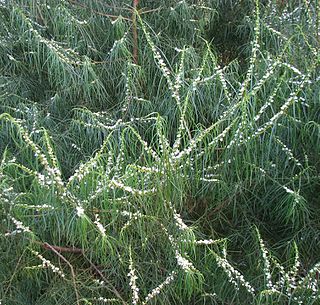
Phrymaceae, also known as the lopseed family, is a small family of flowering plants in the order Lamiales. It has a nearly cosmopolitan distribution, but is concentrated in two centers of diversity, one in Australia, the other in western North America. Members of this family occur in diverse habitats, including deserts, river banks and mountains.

Nundle is a village in the New England region of New South Wales, Australia. It was formerly the centre of Nundle Shire local government area, but most of this area, including the village of Nundle, was absorbed into Tamworth Regional Council in 2004. The village is 400 km north of Sydney and about 56 km south east of Tamworth past Chaffey Dam via a good sealed road. In the 2006 census Nundle had a population of 289. Nundle is located at the southern end of Fossickers Way.

Euphrasa arguta is a plant from the genus Euphrasia (eyebrights) within the family Orobanchaceae.

Myoporum insulare, commonly known as common boobialla, native juniper or blueberry tree is a flowering plant in the figwort family Scrophulariaceae and is endemic to coastal areas of Australia. It is a shrub or small tree which grows on dunes and coastal cliffs, is very salt tolerant and widely used in horticulture.

Myoporum parvifolium, commonly known as creeping boobialla, creeping myoporum, dwarf native myrtle or small leaved myoporum is a plant in the figwort family, Scrophulariaceae. It is a low, spreading shrub with long, trailing stems and white, star-shaped flowers and is endemic to southern Australia including Flinders Island.

Myoporum viscosum, commonly known as sticky boobialla, is a plant in the figwort family, Scrophulariaceae and is endemic to South Australia. It is unusual in that sometimes, especially when the leaves are crushed, it has an extremely unpleasant smell.

Dampiera stricta is an erect perennial subshrub in the family Goodeniaceae. The species, which is native to Australia, grows to between 0.2 and 0.6 metres in height. It produces blue flowers between August and January in its native range. It occurs in the states of Tasmania, Victoria, New South Wales and Queensland.

The Boorganna Nature Reserve is a protected nature reserve located northwest of Taree on the Comboyne Plateau in New South Wales, Australia. The 396-hectare (980-acre) reserve, managed by the NSW National Parks & Wildlife Service, was gazetted in 1904 and is the second oldest nature reserve in the state. The reserve features various forest types, including stands of sub tropical rainforest of which the large rosewood, yellow carabeen and small leaf fig are particularly noteworthy. The reserve is a remnant of the former extensive rainforest on the Comboyne Plateau. The plateau was cleared between 1900 and 1925. Australian red cedar was logged in the area in the nineteenth century. Originally proposed to be part of the world heritage rainforest group. The exploration, knowledge, uses and history of this area by Indigenous Australians is not well known in the present day.

Euphrasia collina is a perennial herb or subshrub in the genus Euphrasia. Plants grow to between 5 and 60 cm high and have leaves with 1 to 6 teeth per side.The flowers may be white, blue, pink or purple, sometimes blotched with yellow on the lower petal.

Drabastrum is a monotypic genus of herbs or subshrubs in the family Brassicaceae. The sole species is Drabastrum alpestre which is native to New South Wales and Victoria in Australia.

Olearia tomentosa, commonly known as the toothed- or downy daisy bush, is a shrub or subshrub species in the Asteraceae family.

Myoporum floribundum, commonly known as weeping myoporum or slender myoporum, is a sour-smelling glabrous shrub in the family Scrophulariaceae endemic to a small area of New South Wales and Victoria in Australia. It has long, thin, drooping leaves and profuse white flowers in clusters along the stems in spring. Although it is uncommon in nature, it has long been available as a popular garden plant.

Eucalyptus bancroftii, commonly known as Bancroft's red gum or orange gum, is a species of tree that is endemic to eastern Australia. It has smooth bark, lance-shaped or curved adult leaves, flower buds usually arranged in groups of seven, white flowers and cup-shaped, conical or hemispherical fruit.

Myoporum bateae is a flowering plant in the figwort family Scrophulariaceae and is endemic to the south coast of New South Wales. It is a sweet-smelling glabrous shrub. Although it is sometimes used as an ornamental it is rare in nature, although not endangered at present.

Myoporum betcheanum, commonly known as mountain boobialla is a plant in the figwort family, Scrophulariaceae. It is a shrub or small tree with long, narrow leaves that are a darker green on their upper surface than the lower. Its flowers have five white petals and are arranged in small groups in the leaf axils. The fruits which follow are more or less spherical, soft, cream coloured drupes. As its common name suggests, this plant is restricted to higher places, around 1,000 metres (3,000 ft) above sea level. It occurs in the McPherson Range and nearby mountains of New South Wales and Queensland.

Eucalyptus cosmophylla is a tree of the genus eucalyptus that is native to South Australia, commonly occurring in the southern Mount Lofty Ranges and Kangaroo Island.

Jovellana is a genus of flowering plants in the family Calceolariaceae. It was formerly included in Scrophulariaceae, and is still listed by some authorities as belonging there. However, recent molecular research indicates that the family Scrophulariaceae was polyphyletic, meaning that it contained more than one lineage with different parents. So several of its genera - including Jovellana - have been split off and assigned to new or existing families.
























